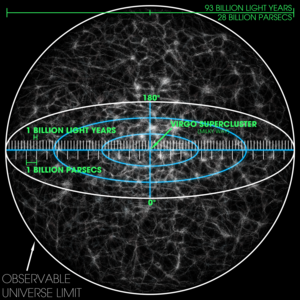Obsavabul univas
Di obsavabul univas bi a ball-shaped rijion of di univas komprising all mata wen we fit obsav from Earth or it space-bazed teleskops and exploratory probes at di present time; di elektromagnetik radiashion from dis objects has had time to reach di Sola System and Earth since di beginning of di cosmological expansion. Inishially, it dé estimated say there it fit bi 2 trillion galaxies de di obsavabul univas.[1][2] Di nomba reduce for 2021 to only several hundred billion bazed on data from Niu Horizons.[3][4][5] Assuming di univas dé isotropik, Di distans to di edj of di obsavabul univas rofly dé the same in evri dairekshion. Dat is, di obsavabul univas bi a sferikal rijion centad on di obsava. Evri lokashion for di univas get it own obsavabul univas, wen fit or no fit ovalap with di one wen Earth bi di centa.
Di word obsavabul for dis sense no dé refer to di kapability of modern teknoloji to detet laight or other informatlshion from any objekt, or whether anything to bi deteted dé. It refer to di fysikal limitwen speed of light itself kreate. No signal fit travel faster than light. Hence a maximum distans, wen we been dé kol di partikul horizon, beyond which nothing fit dé deteted, as di signals no fit reach us yet. Sometimes astrofysicists distinguish between di obsavabul univas and di visibul univas. Di former inklude signals since di end of di inflationary epoch, while di latter inkludes only signals emitted since recombination.[note 1]
Akording to kalkulashions, Di kurrent komuvin distans to partikuls from which the kosmic mikrowave background radiashion (KMBR) was emitted, which represents di radius of di visibul univas, be about 14.0 billion parsecs (about 45.7 billion laight-years). Di komuvin distans to the edj of the observabul univas bi about 14.3 billion parsecs (about 46.6 billion laight-years),[6] about 2% larjer. Di radius of di obsavabul univas is therefore estimated to be about 46.5 billion laight-years.[7][8] Using the critical density and di diameta of di obsavabul univas, di total mass of ordinary mata in di univas can bi calculated to bi abaut 1.5×1053 kg.[9] In November 2018, astronomers reported that extragalactic background light (EBL) amounted to 4×1084 photons.[10][11]
As di univas expansion dd accelerate.
Referens
[chenj-am | chenj-am for orijin]- ↑ Conselice, Christopher J.; et al. (2016). "Di Evolushion of Galaxy Number Density at z < 8 and It Implikashions". Di Astrofysikal Journal. 830 (2): 83. arXiv:1607.03909v2. Bibcode:2016ApJ...830...83C. doi:10.3847/0004-637X/830/2/83. S2CID 17424588.
- ↑ Fountain, Henry (17 October 2016). "Two Trillion Galaxies, at di Very Least". New York Times. Retrieved 17 October 2016.
- ↑ Lauer, T. R.; Postman, M.; Spencer, J. R.; Weaver, H. A.; Stern, S. A.; Gladstone, G. R.; Binzel, R. P.; Britt, D. T.; Buie, M. W.; Buratti, B. J.; Cheng, A. F.; Grundy, W. M.; Horányi, M.; Kavelaars, J. J.; Linscott, I. R.; Lisse, C. M.; McKinnon, W. B.; McNutt, R. L.; Moore, J. M.; Núñez, J. I.; Olkin, C. B.; Parker, J. W.; Porter, S. B.; Reuter, D. C.; Robbins, S. J.; Schenk, P. M.; Showalter, M. R.; Singer, K. N.; Verbiscer, A. J.; Young, L. A. (2022). "Anomalous Flux for di Kosmik Optical Background Detected with New Horizons Obsavashions". Di Astrofysikal Journal Letters. 927 (1): l8. arXiv:2202.04273. Bibcode:2022ApJ...927L...8L. doi:10.3847/2041-8213/ac573d.
- ↑ Lauer, Todd (12 January 2021). "NOIRLab Scientist Find di Univas to dé Brighter than Expected". NOIRLab. Retrieved 12 January 2021.
- ↑ Lauer, Tod R.; Postman, Marc; Weaver, Harold A.; Spencer, John R.; Stern, S. Alan; Buie, Marc W.; Durda, Daniel D.; Lisse, Carey M.; Poppe, A. R.; Binzel, Richard P.; Britt, Daniel T.; Buratti, Bonnie J.; Cheng, Andrew F.; Grundy, W. M.; Horányi, Mihaly; Kavelaars, J. J.; Linscott, Ivan R.; McKinnon, William B.; Moore, Jeffrey M.; Núñez, J. I.; Olkin, Catherine B.; Parker, Joel W.; Porter, Simon B.; Reuter, Dennis C.; Robbins, Stuart J.; Schenk, Paul; Showalter, Mark R.; Singer, Kelsi N.; Verbiscer, Anne J.; Young, Leslie A. (11 January 2021). "Niu Horizons Obsavashions of di Kosmik Optikal Background". Di Astrofysikal Journal. 906 (2): 77. arXiv:2011.03052. Bibcode:2021ApJ...906...77L. doi:10.3847/1538-4357/abc881. hdl:1721.1/133770. S2CID 226277978.
- ↑ Gott III, J. Richard; Mario Jurić; David Schlegel; Fiona Hoyle; et al. (2005). "A Map of di Univas" (PDF). Di Astrofysikal Journal. 624 (2): 463–484. arXiv:astro-ph/0310571. Bibcode:2005ApJ...624..463G. doi:10.1086/428890. S2CID 9654355.
- ↑ "Frequently Asked Questions in Kosmoloji". astro.ucla.edu. Retrieved 2023-09-15.
- ↑ Lineweaver, Charles; Davis, Tamara M. (2005). "Misconceptions about the Big Bang". Scientific American. 292 (3): 36–45. Bibcode:2005SciAm.292c..36L. doi:10.1038/scientificamerican0305-36.
- ↑ See the "Mass of ordinary matter" for dis sekshion in this article.
- ↑ Overbye, Dennis (3 December 2018). "All di Light There Is to See? 4 x 1084 Photons". The New York Times. Retrieved 4 December 2018.
- ↑ The Fermi-LAT Collaboration (30 November 2018). "A gamma-ray determination of the Universe's star formation history". Science. 362 (6418): 1031–1034. arXiv:1812.01031. Bibcode:2018Sci...362.1031F. doi:10.1126/science.aat8123. PMID 30498122.
Point go mistek: <ref> tags exist for a group named "note", but no corresponding <references group="note"/> tag was found

